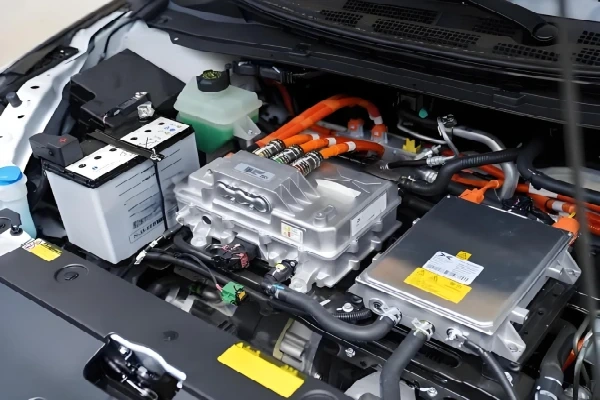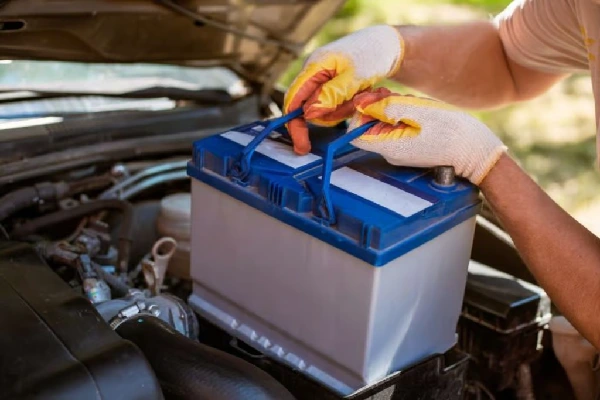
- Part 1. Why car battery weight matters
- Part 2. Car battery structure
- Part 3. What makes a car battery heavy
- Part 4. Average weight by battery type
- Part 5. Average battery weight by vehicle type
- Part 6. Factors that affect battery weight
- Part 7. How to find or calculate car battery weight
- Part 8. Which type is the lightest?
- Part 9. Heavy vs. light car batteries
- Part 10. Car battery weight and electric vehicles
- Part 11. Final thoughts
- Part 12. FAQs
Quick Answer A typical lead-acid car battery weighs between 30–50 lbs (13.6–22.7 kg), while a lithium-ion car battery usually weighs only 10–20 lbs (4.5–9.1 kg).
Large SUV or truck batteries can reach up to 80 lbs (36 kg).
Part 1. Why car battery weight matters
Car battery weight might not be the first thing that comes to mind when thinking about your vehicle, but it plays a crucial role in performance, efficiency, and safety.
Here’s why it matters:
- Performance: A heavier battery increases total vehicle weight, reducing acceleration and handling responsiveness.
- Fuel Efficiency: Every extra pound makes the engine work harder, slightly lowering fuel economy.
- Durability: Extra weight puts additional load on the suspension and chassis, leading to more wear.
- Safety & Installation: Knowing the exact weight ensures proper lifting and secure mounting during replacement.
Part 2. Car battery structure
Understanding the components of a car battery helps in grasping why they weigh what they do. A standard car battery typically includes the following:
- Lead Plates: These are the primary weight contributors. Lead is dense and heavy, which provides the necessary energy storage capacity.
- Electrolyte Solution: Usually a mix of sulfuric acid and water, this solution facilitates the chemical reactions needed to produce electricity.
- Plastic or Metal Casing: The outer shell that protects the internal components. While not extremely heavy, the casing does add to the total weight.
- Connectors and Terminals: Made of metal, these parts add some weight, though they are relatively minor compared to the lead plates and electrolytes.
Part 3. What makes a car battery heavy
Understanding what’s inside helps explain the weight difference between battery types.
A standard car battery includes:
- Lead Plates: The main source of weight. Lead is dense and heavy but crucial for energy storage.
- Electrolyte Solution: A sulfuric acid–water mix that enables chemical reactions.
- Casing: A protective plastic or metal shell.
- Connectors & Terminals: Metal parts that add minor extra weight.
Part 4. Average weight by battery type
| Battery Type | Average Weight (lbs / kg) | Common Use | Key Notes |
|---|---|---|---|
| Lead-acid | 30–50 lbs (13.6–22.7 kg) | Gasoline cars | Heaviest but most affordable |
| AGM (Absorbent Glass Mat) | 30–45 lbs (13.6–20.4 kg) | Modern cars | Better vibration resistance and performance |
| Gel | 30–40 lbs (13.6–18.1 kg) | Specialty vehicles | Leak-proof and low maintenance |
| Lithium-ion | 10–20 lbs (4.5–9.1 kg) | EVs, sports cars | Lightest, longest life, highest cost |
Part 5. Average battery weight by vehicle type
| Vehicle Type | Typical Battery Weight |
|---|---|
| Small cars | 25–35 lbs (11–16 kg) |
| SUVs | 40–60 lbs (18–27 kg) |
| Trucks | 50–80 lbs (23–36 kg) |
| Electric vehicles (full battery pack) | 900–1,500 lbs (408–680 kg) |
Part 6. Factors that affect battery weight
✔ Battery Chemistry- Lead-acid batteries are much heavier than lithium-ion models.
✔ Capacity (Ah or CCA Rating)
- Higher-capacity batteries contain more active materials, adding weight.
✔ Material Composition
- The type and thickness of internal plates determine density.
✔ Design & Size
- Compact, high-efficiency designs reduce total weight without sacrificing performance.
Part 7. How to find or calculate car battery weight
- Check the Manufacturer’s Label – Most include the battery’s net weight.
- Refer to Product Specs Online – OEM or replacement brands often list it clearly.
- Use a Scale – If the label is missing, weigh the battery directly.
- Consider Components – The lead, electrolyte, and casing each contribute to the total weight.
Part 8. Which type is the lightest?
Lithium-ion batteries are by far the lightest, typically 10–20 lbs.
That’s less than half the weight of a standard lead-acid battery. They also last longer, charge faster, and improve vehicle handling and efficiency — making them ideal for electric and high-performance vehicles.
Lead-Acid vs. Lithium Car Batteries: Weight Comparison
| Feature | Lead-Acid | Lithium-ion |
|---|---|---|
| Average Weight | 30–50 lbs | 10–20 lbs |
| Energy Density | 30–40 Wh/kg | 150–250 Wh/kg |
| Lifespan | 3–5 years | 8–10 years |
| Maintenance | Requires occasional check | Maintenance-free |
| Cost | Lower upfront | Higher initial, lower lifetime cost |
A lithium car battery can weigh as little as one-third of a comparable lead-acid unit while providing similar or better performance. That’s why they’re increasingly popular in motorsport, EVs, and high-efficiency vehicles.
Lead Acid vs. Lithium Ion Batteries: A Complete Comparison
Part 9. Heavy vs. light car batteries
| Feature | Heavy Battery (Lead-acid) | Light Battery (Lithium-ion) |
|---|---|---|
| Average Weight | 30–50 lbs | 10–20 lbs |
| Lifespan | 3–5 years | 8–10 years |
| Fuel Efficiency | Lower | Higher |
| Maintenance | Regular | Minimal |
| Cost | Lower upfront | Higher upfront but longer lasting |
In short: Heavy batteries are durable and cheap but less efficient; light batteries cost more but offer better performance and fuel economy.
Part 10. Car battery weight and electric vehicles
While a typical 12-volt battery is fairly light, the main traction battery pack in an electric vehicle is extremely heavy.
For example:
-
-
-
-
- Tesla Model 3 battery pack: ~1,060 lbs (480 kg)
- Nissan Leaf pack: ~660 lbs (300 kg)
- Ford F-150 Lightning pack: ~1,800 lbs (816 kg)
-
-
-
This weight significantly affects range, aerodynamics, and chassis design — one reason EV makers use lightweight materials like aluminum frames to balance it out.
Part 11. Final thoughts
Understanding car battery weight helps you choose the right product for performance, safety, and efficiency.
Whether you’re replacing a traditional 12-volt lead-acid battery or upgrading to a lithium-ion type, remember that weight affects not just installation but also your car’s fuel use and handling.
Before purchasing, always compare:
-
-
-
-
- Battery chemistry and weight
- Capacity and size compatibility
- Long-term maintenance and cost
-
-
-
Knowing these details ensures you “weigh your options” — literally and figuratively — to get the best match for your vehicle.
Part 12. FAQs
How much does a car battery weigh?
Most standard car batteries weigh between 30 and 50 lbs (13.6–22.7 kg). Lithium-ion types are much lighter at 10–20 lbs (4.5–9.1 kg).
Does a heavier battery perform better?
Not necessarily. While heavy lead-acid batteries are durable, lighter lithium batteries improve handling and fuel economy.
Are lightweight batteries safe?
Yes, as long as they meet your vehicle’s required voltage and CCA specifications.
Can I install a lighter battery in my car?
Yes — as long as it fits properly and provides enough starting power. Always confirm the specs match your OEM requirements.
How much does an EV battery weigh?
Full electric car battery packs can range from 900 to 1,500 lbs (408–680 kg) depending on capacity and design.
Related Tags:
More Articles

Battery Load Test: A Comprehensive Guide
Step-by-step battery load test guide for car, solar & industrial use. Learn how to load test a battery, interpret voltage charts, and avoid common mistakes.
The Comprehensive Guide to Battery Balancing and Battery Balancer
Discover how battery balancers improve lithium battery performance, lifespan, and safety. Learn types, functions, and tips to choose the right balancer.
What Is the Best Voltage for a Chainsaw Battery?
Compare 12V-80V chainsaw batteries for light pruning, medium firewood, and professional cutting. See best battery chainsaw with runtime charts and safety tips.
Lithium VS. Alkaline Batteries: A Comprehensive Comparison
Lithium batteries last 3–7× longer than alkaline and perform better in cold weather. Compare lifespan, cost, safety, and best uses to choose the right battery.
Comparing Lithium-Sulfur and Lithium-Ion Batteries: Which is Right for You?
Compare lithium-sulfur (Li-S) and lithium-ion batteries on energy, lifespan, cost, safety, and applications. Best choice for drones, EVs, and electronics.





